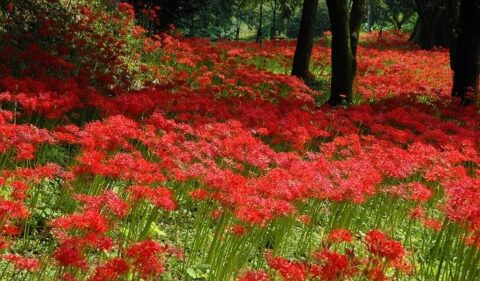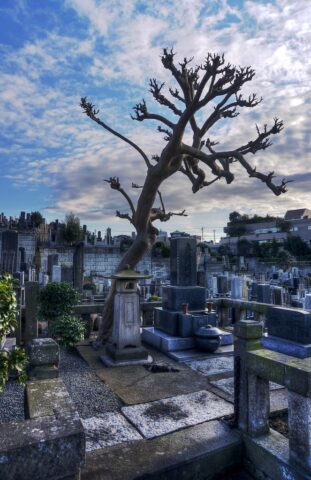The event of worshiping ancestors in Japan fused ancient Japanese beliefs with Buddhism.
The big events that still remain are the equinoctial week and the Obon festival.
Also, since the Obon season is summer, we often take vacations during this period and return to our parents’ homes to worship our ancestors with our families.
Higan

It is one of the miscellaneous clauses in Japan, and the spring equinox and the autumn equinox are set as Chunichi, and there are 7 days each (14 days in total in one year) including 3 days before and after. The Buddhist affairs performed during this period are called the equinoctial week.
“Gokuraku Pure Land” (a type of Pure Land governed by Amida Nyorai, Western Pure Land) in the Pure Land Buddhism is located in the west, and the spring and autumn equinoxes, where the lengths of day and night are the same twice a year, are the sun. Ascends from the east and sets in the west, worshiping the sun setting in the west and thinking of the paradise of the paradise far away is the beginning of the equinoctial week.
However, since the events on the equinoctial week are unique to Japan and not found in Buddhism in India or China, it is presumed in folklore that they originated from the ancient Japanese folk sun beliefs and ancestral beliefs.
“Botamochi” and “Ohagi”, which are made as offerings on the equinoctial week in Japan, are the same, and nowadays it is generally made as a confectionery of less than 10 cm, which is made by lightly wrapping cooked rice and wrapping it in thick bean paste. When it was handmade in various places, there were various botamochi and rice cakes. These names are said to be derived from the peony (spring) and hagi (autumn) that bloom around the equinoctial week.
Obon

Obon is a series of events held in Japan in the summer to worship the spirits of ancestors. It is an event that combines ancient Japanese ancestral beliefs and Buddhism.
It was once held around July 15th of the lunar calendar.
Traditionally, it was celebrated on the day of the mid-year festival, which is July 15th of the lunar calendar. However, Japan has adopted the Gregorian calendar (new calendar / solar calendar) from January 1, 1873. In principle, the Bon Festival was held on July 15th of the new calendar in the decree of the Daijo-kan’s calendar reform, but since many annual events in Japan were based on the old calendar, the season may change due to the adoption of the new calendar depending on the annual event. Something did not fit . Especially in the area where July 15th of the new calendar is the farming season, there was a significant problem, so the time of the Obon festival has become different depending on the region, and there are many areas where August 15th of the new calendar is the Obon festival (monthly delay).
Mukaebi
The wildfire in the evening of the 13th is called Mukaebi. After that, we made various offerings to the deceased in the spirit shelf. Depending on the region, there are also places where you “visit”. Absence visit means to go to a grave where there is no deceased and clean it. Large-scale fireworks such as invitations are also held.
Bonfire
The wildfire on the 16th is called okuribi. The Gozan no Okuribi in Kyoto is famous. Many places have okuribi on the 15th (Nara Takamadoyama capital, etc.).
In addition, there is also a custom of sending to the river, and lanterns are washed away. The point of sending to mountains and rivers is that it is culturally mountains and rivers that the deceased is said to be there, as described in Sakuhi Kamakabe.
In addition, although it is a period to send the deceased, it is from the 16th to the 24th, and he works by visiting the grave as well as picking up.
Bon dance
On the evening of the 16th, the day after the Bon festival on the 15th, men and women of all ages gather and dance in the precincts of temples and shrines. It is said that the dead who escaped the suffering of hell imitated the state of happily dancing. It is the climax of the summer festival. July 15th of the lunar calendar is 15 nights, and the following 16th is 16 nights (Izayoi), that is, the moon becomes a hope (Mochizuki = full moon) on either day. Therefore, if it was sunny, the evening of the 16th was bright with moonlight and I could dance all night.
In recent years, the place is not always “the precincts of temples and shrines”, and it is often held as a non-religious event. A typical example is to build a turret in a plaza where many people gather, such as a station square, and invite stalls to get to know the local community. Since many people return home during the Bon Festival, it also serves as an opportunity for people from each location to meet each other for the first time in a while.
First tray (Hatsubon) / new tray (Uibon)
The first tray that will be greeted after the 49th day of the death of a person is called the first tray (Hatsubon, Uibon) or the new tray (Shinbon, Niibon, Arabon), and there is a custom of offering a particularly thick memorial service. This also depends on the region, but the people of the Hatsubon family perform special rituals by setting up white lanterns at the gates, Buddhist altars, and graves, and giving such lanterns to the people of the Hatsubon family. At other times, patterned tray lanterns and lanterns with white and red colors are erected on the graves.
Buddhist vacation

The Obon holiday was a consecutive holiday that had already taken root in the Edo period, and even after the Meiji era, until 1872 (Meiji 5), there were three consecutive holidays from July 14th to July 16th of the lunar calendar.
However, according to the Daijo-kan Declaration No. 2 “Vacation Day” on January 7, 1873 (Meiji 6), from January 1st to January 3rd (New Year 3rd), from June 28th to June 30th. Until the day (Natsukoshi’s Ooharae) and from December 29th to December 31st (Natsukoshi’s Ooharae), the holidays were consecutive, and Obon was excluded. Since the same year, Obon has never been a legal holiday in either case of the lunar calendar or the adoption of the new calendar month.
In the private sector, companies that are closed even on weekdays around August 15th of the new calendar and people who take vacations are conspicuous. Some companies may also have a summer vacation (bon holiday) due to the overlap of one to two months of summer vacation for school children, students, and students. It is not only a religious event to worship the spirits of ancestors, but also has an aspect of “Obon” as a national vacation and homecoming / travel season. Especially for Christians who are not aware of Buddhist lifestyle, Obon (former Bon) is just a summer vacation. In addition, since the Obon holiday is set around August 15th throughout the country, weekdays are not closed even on July 15th of the new calendar, so in the area of Obon in July of the new calendar mentioned above, July 15th of the new calendar is set. On weekdays, many families visit Obon on Saturdays and Sundays before and after.
Along with Golden Week and the year-end and New Year holidays, highways and public transportation (railways, high-speed buses, aircraft) are very crowded during this period, so it is called a homecoming rush. Since it is treated as a normal “weekday” and is not regarded as a “national holiday” based on the National Holiday Law (Holiday Law), government offices, financial institutions, securities markets, etc. are operating as usual, and are generally used. Even in companies, there are departments and employees who go to work even before the construction called “weekdays”.
Obon is rather the time to fill in for transportation, which is responsible for homecoming and U-turn rush, and for shops, restaurants, hotels, and inns visited by shopping and vacationers. In these workplaces, they take turns taking summer vacation from July to September, and often travel around the old Bon festival, when congestion and fees are at their peak. Companies that are closed on weekdays will be open as usual if the original holiday hits Obon, and may be closed on another weekday before or after Obon.


コメント